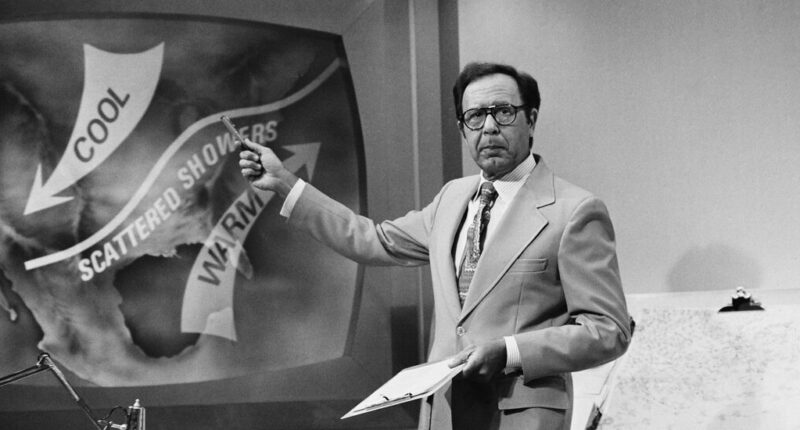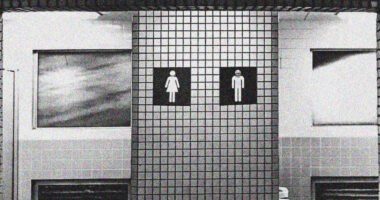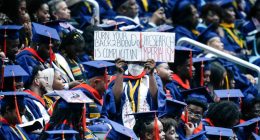
Frank Field, who as a meteorologist brought a groundbreaking credential to his job as a television weather forecaster in New York, and who also had a long career presenting network programs on science and medicine, died on Saturday in Florida. He was 100.
His death was announced by WNBC-TV in New York, where Dr. Field began his broadcast career in 1958.
Dr. Field, a presence on New York and network television for more than 40 years, was not the city’s first popular TV forecaster. But he was different from his predecessors in one significant way.
The most notable of those predecessors (who also became his rivals) were Tex Antoine and Carol Reed. Mr. Antoine drew the mustachioed Uncle Wethbee on his weather maps for the NBC and, later, ABC stations in New York, changing the character’s facial expression and weather-related garb depending on the forecast. Ms. Reed signed off her nightly reports on WCBS-TV with a cheery “Have a happy.” Both enjoyed long runs on television. But neither had expertise in weather science.
“Weather forecasting used to be in a class with reporting real estate transactions for the newspaper,” Dr. Field told The New Yorker for a 1966 profile. “The networks figured it had to be all jazzed up with pretty girls and other gimmicks.”
Bespectacled and “rather professorial in manner,” as he was described in the magazine profile, Dr. Field more than made up for his lack of flash.
Although he did not have a college degree in meteorology — his doctorate was in optometry, a profession he pursued for a time before embarking on a career in television — Dr. Field had been a weather forecaster in the military, a credential that earned him recognition as a meteorologist by the American Meteorological Society. He was a recipient of the society’s Seal of Approval, which recognizes on-air forecasters who provide “sound delivery of weather information to the general public.”
He drew on his technical knowledge to interpret data from weather satellites launched in the emerging space age, and to explain the details of the illustrated weather systems he displayed on television.
He also established himself as a science reporter who covered more than just the weather.
Dr. Field narrated live telecasts of cardiac surgery and organ transplants. He was an advocate for fire-safety programs, describing the best ways to escape a building fire in the book “Dr. Frank Field’s Get Out Alive” (1992) and in an educational DVD for children and their parents, “Fire Is … ” (2006). He also hosted the programs “Medical Update” and “Health Field.”
Perhaps most famously, he publicized the Heimlich maneuver, the lifesaving procedure developed by Dr. Henry J. Heimlich in the 1970s that employs a bear hug and abdominal thrusts to clear food lodged in the throat. Dr. Field brought Dr. Heimlich to his studio for a demonstration.
Dr. Field received a citation at the New York Emmy Awards in 1975 for “reporting developments in the applied sciences.” He was a fellow at the Albert Einstein College of Medicine in New York, where he studied the relationship between weather and health.
Franklyn Field was born on March 30, 1923, in Queens, a son of immigrants from Ukraine. His father was a factory worker.
He was studying geology at Brooklyn College and playing center on the school’s football team — the quarterback was Allie Sherman, who would later be the head coach of the New York Giants — when he enlisted in the Army Air Forces in World War II and was commissioned as a lieutenant.
After the military trained him as a meteorology specialist, he flew over German-occupied France to analyze weather patterns that would affect American bombing runs. He later lectured on meteorology at stateside air bases.
He did not return to Brooklyn College after the war, instead continuing his work in meteorology. He joined the staff of the United States Weather Bureau in Manhattan and headed companies that provided weather data to newspapers and private clients.
But when his wife, Joan, was expecting their first child, he sought a professional career that would provide greater financial stability. He studied optometric engineering at Columbia University, obtained a doctorate from the Massachusetts College of Optometry and worked briefly as an optometrist in the early 1950s.
“If anybody yelled ‘Is there a doctor in the house?’ and I responded, about all I could do for the patient would be to prescribe, nervously, a change of glasses,” he told The New Yorker.
In addition to his nightly weather forecasts, Dr. Field analyzed space missions on network telecasts, explaining the weather conditions that astronauts were likely to face when they touched down in the ocean.
Dr. Field left NBC in 1984 and moved to CBS, where he worked for 11 years. He later had stints at two local television stations in New York, WNYW and WWOR. He retired in 2004.
Dr. Field was also as the senior figure of a TV weathercasting family. His son, Storm (born Elliott David Field), began delivering weather reports on WABC in New York in 1976 and went on to have a long career there and on WCBS (where father and son briefly worked together) and WWOR. Dr. Field’s daughter Allison Field was also a weather forecaster, at WCBS, in addition to pursuing an acting career.
They survive him, as does another daughter, Pamela Field; seven grandchildren; and six great-grandchildren. Dr. Field’s wife, Joan Kaplan Field, died this year. Dr. Field lived in Boca Raton, Fla.
Despite (or perhaps because of) his serious demeanor, Dr. Field became a presence on late-night television.
After Johnny Carson poked fun at him on “The Tonight Show,” Dr. Field (whom Carson jokingly called NBC’s “crack meteorologist”) became an occasional guest on the show.
One night during a rainy spell in New York, Carson and his “Tonight Show” colleagues poured buckets of water on him.
Dr. Field said he appreciated his “Tonight Show” appearances because they gave him national recognition beyond the audiences for his weather, medical and science reports.
“He really gave me a safety rope,” he told The Daily News of New York in 2005. “It was absolutely a lock — you couldn’t fire Frank Field.”
In December 1985, Dr. Field’s popularization of the Heimlich maneuver saved his life.
He was dining at a Manhattan restaurant with the CBS sportscaster Warner Wolf when a piece of roast beef became lodged in Dr. Field’s throat. “There was no pain,” he later told The New York Times. “I tried to swallow and could not. I tried to cough. I was perfectly calm, until I realized I couldn’t breathe.” He was also unable to speak to Mr. Wolf to convey his distress.
“So I pointed to my throat and stood up, to give him access,” Dr. Field said. “He did it the first time, and it didn’t work. I thought: ‘My God! It doesn’t work. If I fell unconscious, I wouldn’t make the 11 o’clock news.’”
When Mr. Wolf tried again, he expelled the meat.
“Warner had never done it,” Dr. Field said, “but he had seen me demonstrate it on television.”
Source: | This article originally belongs to Nytimes.com








